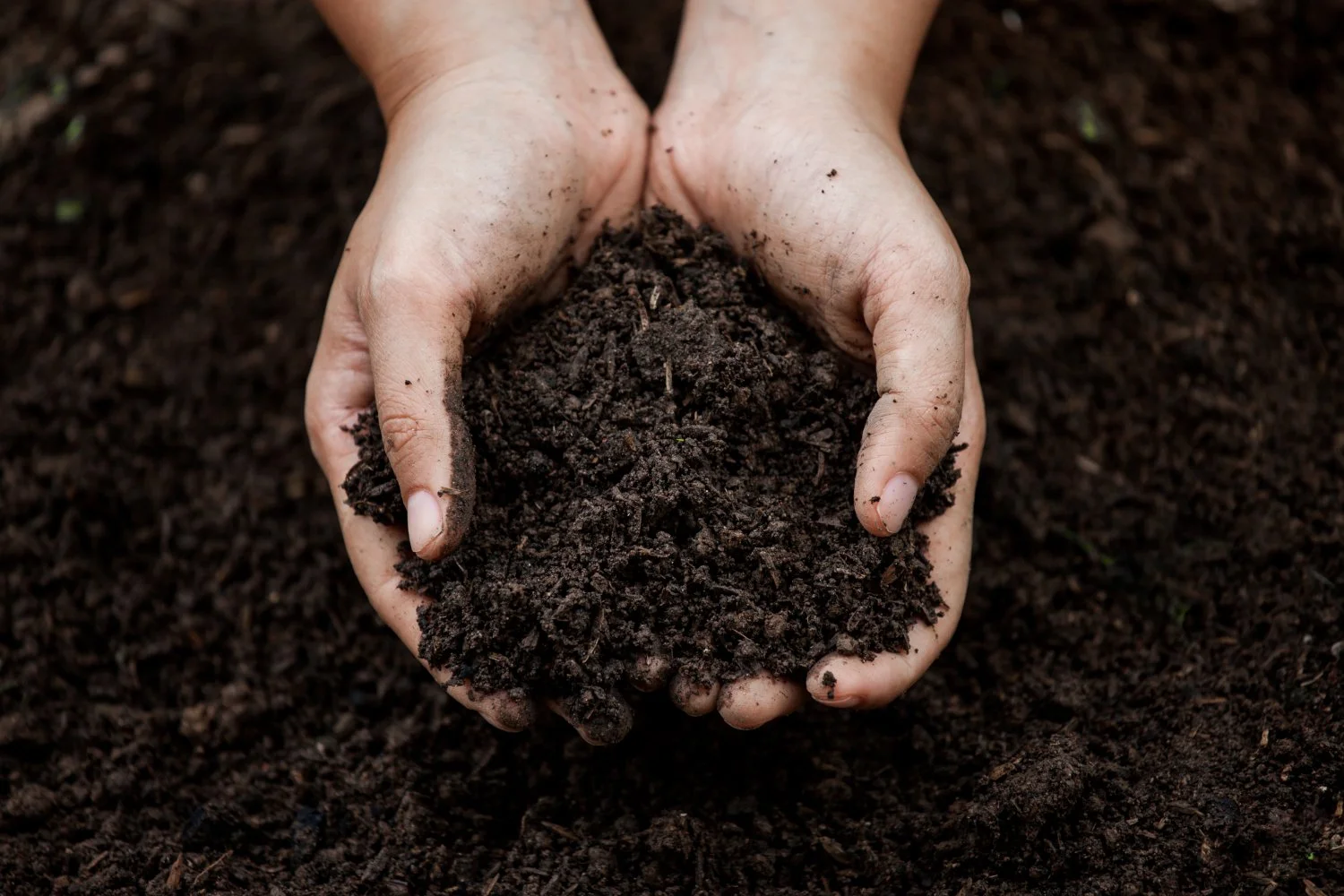April 2024
Gardening is a fantastic activity that provides a beautiful and neat garden. It involves different practices for growing plants (e.g., vegetables and flowers), such as sowing and planting, tilling the soil, watering the plants, pruning, etc. As satisfying and exciting as gardening can be, we can unintentionally burden the environment with our activities.
However, eco-friendly gardening, also known as organic or sustainable gardening, is a great way to care for our garden without harming the environment. Although eco-friendly gardening requires more effort and knowledge in the first place, it helps protect the environment, support biodiversity, and create a healthy and sustainable garden in the long run.
In this manual entry, we compile the most relevant aspects to ensure our gardening activity is environmentally friendly.
PLANT SELECTION
Plant local native wildflowers. The significant advantage is that they will thrive almost entirely without care, as they are optimally adapted to this location precisely. This means you save money and time and support the local ecosystem.
WHY NATIVE PLANTS?
Start by opting for native plants or plants that are generally adapted to the local climate and soil conditions. Here are several benefits of native plants:
They are more robust and require less water, fertiliser, pesticides and care than exotic plants as they have developed defence mechanisms against local environmental conditions and pests.
When you grow native plants in your garden, you help protect local biodiversity. Native plants are a source of food and shelter for many native animals. Flowers provide nectar for pollinators such as bees and butterflies, while seeds and fruits provide food for birds and small mammals.
Planting native plants can help prevent the spread of invasive plant species that could disrupt native ecosystems and displace native species.
WHAT IS A SUSTAINABLE PLANT?
Here is how to choose a sustainable plant:
Native plants are the most sustainable plants you can choose.
By choosing regionally produced plants, you support local producers and avoid enhancing the high carbon footprint that the transportation of non-regional plants carries.
Prefer durable plants such as succulents and herbs that require minimum care and input. Most aromatic plants, such as lavender, rosemary, lemon thyme, lemongrass, mint, etc., have low care needs and repel insects like mosquitoes and flies.
Opt for sustainably produced plants.
You find them at weekly markets, specialised nurseries, farm shops, and Organic Stores →.
Identify organically grown houseplants by checking if they carry the appropriate EU organic certification label.
Prefer perennials, which resprout in the spring. Perennials tend to be more resilient than annuals and save money because you won't have to buy new plants yearly. Examples of these are petunias, hardy geraniums, peonies, and chrysanthemums. There are also perennial varieties of Sunflowers and Daisies.
Ask your local florists or nurseries for more ideas.
Minimise water waste
Choose efficient irrigation methods such as drip irrigation or, for small-scale gardening, a water can. Save rainwater in a bucket at the corner of your garden or rooftop to water your plants. Rainwater is the most sustainable option and is also of the highest quality, as it doesn't contain any dissolved impurities or minerals that could harm your plant.
Soil Care
Proper Soil → practices are essential to Eco-Friendly Gardening →, as they can improve soil quality and maintain microflora Biodiversity →.
Add compost and organic matter to increase soil fertility and improve natural properties.
Reduce tillage practices to promote the unhindered growth of helpful soil organisms and carbon storage.
Environmentally-friendly pesticides & fertilisers
Environmentally friendly plant protection products and fertilisers are often more expensive than conventional products, but they help protect the environment and maintain the long-term health of your garden. Ask your local garden supply store or nursery for eco-friendly products. They often have the experience to guide you to the best options for your area.
How do I recognise environmentally friendly crop protection products & fertilisers?
Here are some tips on how to identify eco-friendly products:
Certifications & labels - Look for certifications and labels on products that indicate that they meet specific environmental standards. Except for the EU organic certification label, in Germany, for example, the “Bioland” or “Naturland” organic seal indicates environmentally friendly products.
Ingredients - Read the ingredients carefully. Environmentally friendly pesticides and fertilisers use natural or organic ingredients and avoid synthetic chemicals.
Environmental effect - Read the product's label to learn about its ecological impact on bees and other pollinating insects.
Sustainable Packaging → - Pay attention to the packaging of the product. Eco-friendly products often use eco-friendly packaging materials and attempt to minimise plastic waste.
Avoid the application of chemals
Applying synthetic pesticides and fertilisers can harm the environment and Wildlife →.
Instead, choose natural pest control and fertilisation methods such as:
Mechanical or manual removal of weeds.
Natural and Biological pest control, such as traps and predators (mites, ladybeetles, etc). Ask your local agricultural shops for specific suggestions.
Homemade pest repellents such as garlic, chilli sprays, and neem oil.
Apply compost and manure for organic fertilisation.
Practice Mulching
Cover your Soil → with hay, straw, tree leaves, chipped bark, wood shavings, tree trimmings, sawdust and chopped branches. Covering the soil with layers of mulch offers several benefits for the garden:
Retains soil moisture, which reduces the need for more frequent watering, especially during dry periods.
Suppresses the growth of weeds in a natural way.
Regulates soil temperature as it acts as an insulator. This is particularly important to mitigate extreme temperatures in summer and winter.
Protects the soil from erosion.
Helps retain the soil nutrients.
Some mulch materials, such as straw or chipped bark from cypress or cedar trees, repel bugs.
You can buy mulch products on the market or make your own. Gather the organic residues from your garden and apply them to the soil.
Promote Biodiversity
Your garden and balcony can form a small, vivid ecosystem, a biological community of interacting organisms and their physical environment.
Biodiversity → means biological diversity and refers to the variety of life forms. In short, the better the conditions for an ecosystem, the higher the biodiversity in your garden or on your balcony will be.
The good news, we can do a lot here.
In the following, we list the most basic examples:
Create habitats for birds, insects, and other animals in your garden by creating spots that support their survival, such as hedges or nests.
Provide water sources, especially in summertime.
Mow less often to allow lawn weeds such as dandelions to flower, as they can comprise invaluable food sources for many pollinators.
Never use pesticides on plants in flower.
Grow plants that are useful for Pollinators →.
Grow a range of plants for year-round flowering to ensure food all year round.
Avoid plants with double or multi-petalled flowers, as insects can not access the pollen.
Browse the net to determine which plants are for your area and your location,
Remember to ask your national and regional nature conservation organisation for more information and tips on Wildlife → in your area and how you can support and protect it.
Reduce energy consumption
Use energy-efficient garden tools. When using electric devices such as Lawn Mower or Pruning Shears, opt for battery-operated ones as they consume less energy than mains-operated ones.
Learn more about Sustainable Appliances & Tools →.
Minimise waste & compost
Here are some rules to minimise Waste → generation in your garden.
Reuse your plant pots. When not reusing your gardening tools or pots, recycle them. Ask at the nursery - they often take back plastic pots to reuse them.
Opt for sustainable materials such as wood for your plant beds.
If you apply chemical fertilisers and pesticides, follow the label instructions for proper cleaning and disposal.
Do not rush to throw away your garden’s organic waste. Instead, make your homemade compost to create nutrient-rich humus that improves your soil’s productivity.
You can also add kitchen leftovers to your compost, thus minimising kitchen waste.
The main ingredients you can add to your compost are:Grass/plant fragments
Dry leaves
Chopped wood/bark
Fruit and vegetable peels
Coffee grounds
Eggshells
Shredded newspaper
LightING
Do you light up your garden or balcony at night?
This might cause light pollution, also known as light smog, which refers to the excessive, unwanted and often harmful illumination of the nocturnal environment by artificial light sources.
Let’s think about it: does my balcony or garden need to be lit up at night? What purpose does it serve, and is this purpose related to the many disadvantages of artificial night lighting?
Why is light pollution harmful to the environment?
Disruption of natural life cycles: Many animals, especially nocturnal species such as birds, bats, insects, and sea turtles, rely on natural darkness to regulate their life cycles, feed, and reproduce. Light pollution can disrupt their activities and upset their life rhythms.
Loss of biodiversity: Light pollution can drive nocturnal animals away from habitats where they would usually be found, leading to Biodiversity → loss and the decline of certain species.
Waste of energy: A lot of light shining into the sky or unused areas is ultimately useless and increases energy consumption.
Reduce light pollution
Here is how to light your balcony or garden in an environmentally friendly way, if necessary. We can protect the environment, save energy, and enjoy the natural night sky.
Use targeted, shielded lighting that shines only where needed and prevents stray light.
Use motion detectors & timers to switch on the lighting only when needed.
Use less intense lighting overall and choose lamps with lower lumen values where they are sufficient.
Support or advocate for municipal light pollution ordinances that regulate how public lighting is installed and used.
Educate yourself on the effects of light pollution and share your knowledge to raise awareness of the issue.
Learn from the experts
Lastly, browse the web and research your library catalogue for expert knowledge on eco-friendly gardening. The more informed you are, the more effectively you can implement eco-friendly practices in your garden.
Online sources for eco-friendly gardening knowledge
Here are some portals and websites to help you get started:
Environmental organisations: The EEB is Europe’s largest network of environmental citizens' organisations, which brings together over 180 member organisations from 40 countries.
Social media: Many gardeners share their experiences on social media platforms, like YouTube, Instagram or Pinterest. To find inspiration, search hashtags like #organicgardening or #sustainablegarden.
Remember to always check the source for reliability.Blogs: Passionate gardeners share their tips on sustainable gardening. Some popular blogs are
garten-fraeulein.de (G)
mein-schoener-garten.de (G)
joegardener.com/blog (Florida, USA)
planetnatural.com/blog (Montana, USA)
nodighome.com (UK)
adamynyrardd.cymru/en (West Wales)
blog.theenduringgardener.com (Ireland)
myhomefarm.co.uk/category/garden (UK)
Online Forums: Online gardening communities allow you to ask questions, get advice, and share experiences with other gardeners. Some examples are gardening-forums.com, forum.gardenersworld.com or the gartenforum.de/ for German speakers.
Local Environmental & Gardening Associations: Check local media for resources, organisations, groups or events focused on eco-friendly gardening in your area.
Courses & Workshops: Look for classes and workshops offered by gardeners or conservation organisations in your area. Such projects usually provide knowledge as well as practical experience. Or browse the web to find innumerable online courses. For example learningwithexperts.com/gardening
Expert books on eco-friendly gardening
Here are some books that might help you start your journey as an eco-friendly gardener.
“How to Create an Eco Garden: The Practical Guide to Sustainable and Greener Gardening” by John Walker
“How to Become a Gardener: Find Empowerment in Creating Your Food Security” by Ashlie Thomas
“Sustainable Garden: Projects, Insights and Advice for the Eco-Conscious Gardener” by Marian Boswall and Jason Ingram
“Resilient Garden: Sustainable Gardening for a Changing Climate” by Tom Massey
“Dry Climate Gardening: Growing Beautiful, Sustainable Gardens in Low-Water Conditions” by Noelle Johnson
“The Humane Gardener: Nurturing a Backyard Habitat for Wildlife” by Nancy Lawson
“The Regenerative Garden: 80 Practical Projects for Creating a Self-Sustaining Garden Ecosystem” by Stephanie Rose
Learn more
Check our sources: Bibliography →


























